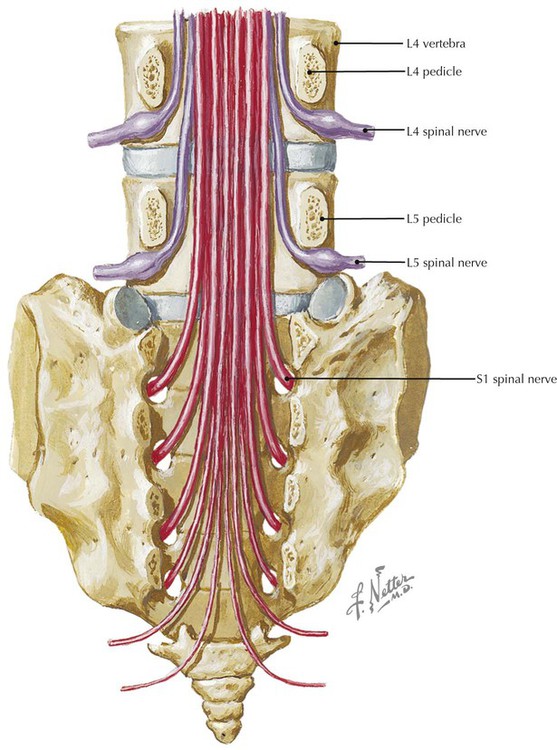Back and Spinal Cord





Thoracic Spine
• The thoracic region of the vertebral column is the least mobile of the presacral vertebral column because of thin intervertebral discs, overlapping spinous processes, and the presence of ribs. This minimizes the potential for disruption of respiratory processes and maximizes stability of the thoracic spine.
• The normal thoracic curvature (kyphosis) is due almost entirely to the bony configuration of the vertebrae, whereas in the cervical and lumbar regions thicker discs also contribute to the respective curvatures in these regions.
• The overlapping of angled osseous structures of the thoracic spine's posterior elements and costovertebral junctions may result in confusion pertaining to bone changes caused by trauma or tumors on radiographs or cross-sectional images. Volume rendered displays can, in such cases, provide anatomic clarity not easily perceived on other image displays.
Lumbar Vertebrae
• Spondylolisthesis refers to the anterior displacement of a vertebra in relation to the inferior vertebra; it is most commonly found at L5/S1because of a defect or non-united fracture at the pars interarticularis (the segment of the vertebral arch between the superior and inferior facets).
• There are typically five lumbar vertebrae, but the fifth lumbar may become fused with the sacrum (sacralization of L5) or the first sacral vertebrae may not be fused with the remaining sacral vertebrae (lumbarization of S1).
Structure of Lumbar Vertebrae


• Contrast material that had been injected into the nucleus pulposus has extravasated through a tear in the anulus fibrosus in this CT scan.
• Note that the main (axial) section shows the spinous process, lamina, and inferior facets of the vertebra above and the superior facets of the segment below.
• The vertebral arch is composed of the two (right and left) pedicles and lamina.
Lumbar Spine
• The parasagittal CT image is at the level of the blue lines in the coronal and axial views. The axial section is at the level indicated by the red line. The coronal reconstruction is at the level of the green line.
• It is clinically important that the lumbar intervertebral foramina (also called neuroforamina or nerve root canals) extend superior to the associated disc. Herniated L4/5 disc fragments that extend upward and laterally may impinge on the exiting L4 root within the L4/5 intervertebral foramen, whereas herniation of an L4/5 disc fragment posteriorly and inferiorly may impinge on the L5 nerve root.
Sacrum
• The division of spinal nerves into dorsal and ventral rami occurs within the sacral canal so that the primary rami exit the sacrum via the anterior and posterior sacral foramina.
• The auricular surface of the sacrum is for articulation with the ilium forming the complicated sacroiliac joint (SIJ). Arthritis in this joint may be a source of lumbago.
• In osteoporotic patients, the sacrum is less able to resist the shearing force associated with the transfer of upper body weight to the pelvis; this may result in a vertical “insufficiency” fracture.
Vertebral Ligaments
• The anterior longitudinal ligament tends to limit extension of the vertebral column, whereas the posterior ligament tends to limit flexion.
• Herniation of intervertebral discs at the thoracic/lumbar junction is common because the thoracic region of the spine is relatively immobile compared to the lumbar and cervical regions.
Ligamentum Flavum
• The ligamentum flavum contains elastic tissue that prevents the ligament from being pinched between the lamina when the vertebral column is hyperextended.
• Anesthesiologists use penetration of the ligamentum flavum as an indicator that the needle has reached the epidural space for epidural anesthesia.
Spinal Nerves, Lumbar

• The L4 spinal nerve passes caudal to the L4 pedicle to exit the spinal canal through the L4/L5 neuroforamen (intervertebral foramen).
• Similarly, the L5 nerve passes caudal to the L5 pedicle to exit the spinal canal through the L5/S1 neuroforamen.
• Coronal MR images may clearly show disc fragments that have herniated laterally and how they potentially affect nerve roots within or lateral to the neuroforamen.
Spinal Cord, Nerve Roots

• In this CT image the rootlets of the dorsal roots are represented by the delicate black inclined lines; the gray material represents opacified (contrast-enhanced) cerebrospinal fluid (CSF) within the subarachnoid space. The CSF was opacified by an intradural injection of iodinated contrast material that was injected with a very fine needle during a simple outpatient procedure.
• For patients who cannot undergo MRI—for example, those with a pacemaker—CT myelography is an alternative imaging procedure that is capable of showing very delicate anatomy (e.g., spinal nerve rootlets).
Back, Lower Paraspinal Muscles
• Spasm in the erector spinae is associated with lumbago as the muscles spastically contract to reduce spinal movements.
• The erector spinae muscle group is entirely innervated by segmental dorsal rami.
• The three longitudinal components of the erector spinae (from lateral to medial) are the iliocostalis, longissimus, and spinalis.
Deep Muscles of the Back
• The deep back muscles are primarily responsible for delicate adjustments between individual vertebrae that correlate with changes in posture.
• The three components of the transversospinalis muscle group are semispinalis, multifidus, and rotatores, but they are not equally developed in all regions (multifidus is best developed in the lumbar region).
• The deep back muscles are all innervated by segmental dorsal rami.
Lumbar Region, Cross Section

• Imbalanced patterns of erector spinae muscle activity and reduced trunk extension strength are associated with low back pain.
• Perirenal and pararenal fat is thought to act as a cushion that protects the kidney from injury.
• The diaphragm, psoas, quadratus lumborum, and transversus abdominis comprise the posterior relations of the kidney.




























